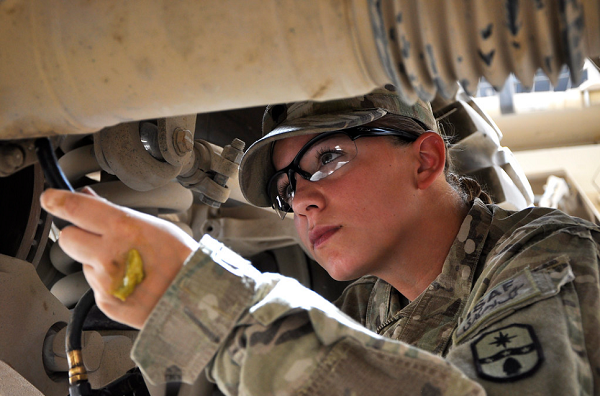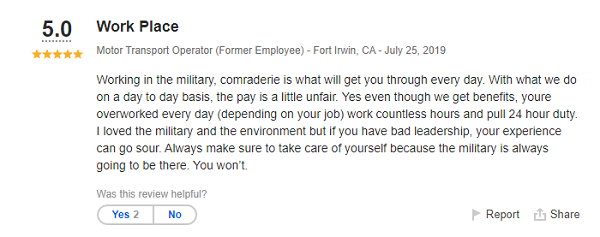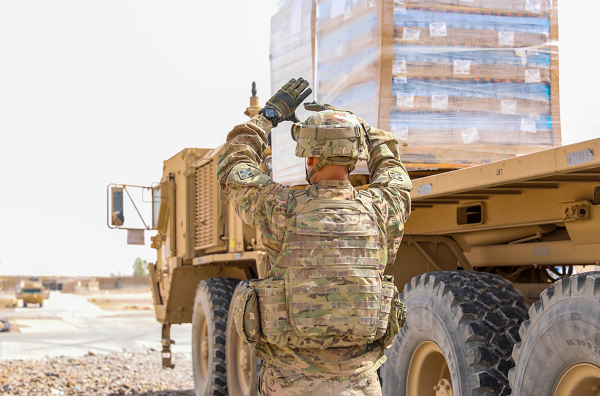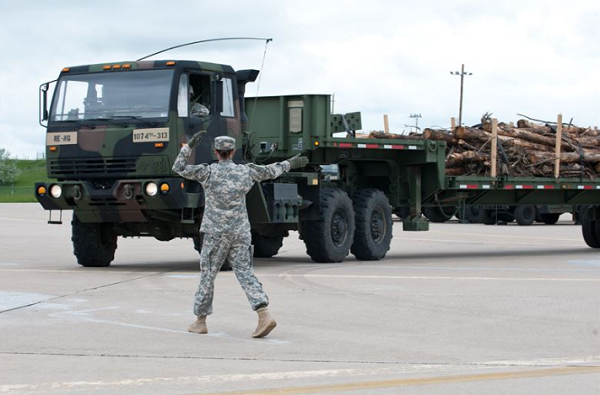Army Motor Transport Operator (MOS 88M) provide Army mobility through the transport of personnel and cargo.
Motor Transport Operators both supervise and operate wheel vehicles.
Operators are responsible for driving wheel vehicles and equipment over a variety of different terrains and roadways both on and off the battlefield.
Related Article – US Army Careers List for 2020
Qualifications and Training
To enter into this MOS soldiers must take the ASVAB and receive a minimum score of 85 on the Operators & Food (OF) portion.
Once individuals pass all entry level testing, including medical and physical evaluations, they will attend Basic Combat Training for 10 weeks.
Upon successful completion of Basic Combat Training, soldiers will attend Advanced Individual Training for 7 weeks.
Advanced Individual Training consists of classroom and simulation testing with over 200 training hours dedicated to actual vehicle and field training.
Skills that are helpful in this MOS:
- Driver education experience
- Interest in a job involving diving and mechanics
Related Article: Army Wheeled Vehicle Mechanic (MOS 91B): Career Details
What are the Job Duties of a Motor Transport Operator?

The soldiers in this MOS operate medium and heavy tactical vehicles.
With additional training, soldiers can be expected to drive a multi-purpose vehicle, special unit off-terrain vehicle or heavy equipment transporter.
Soldiers in this MOS are trained and will be required to drive in all terrains, weather and even in black-out situations using night-vision.
Motor Transport Operators use different tools to ensure they are navigating correctly.
Some of these tools include road, topographical and strip maps.
Prior to transporting cargo, Operators will inspect any cargo and its content.
They ensure that the cargo is secured to the vehicle and the contents are being transported in a safe manner.
A portion of their time will be spend assisting loading cargo and operating different loading equipment.
When transporting personnel, Operators assist in loading, unloading and ensure their safety.
Because soldiers are driving in foreign areas, they are required to recognize foreign traffic signals, use hand signals and arm signals.
Another component to communication functions is the task of operating radio communication and digital communication equipment.
They can sometimes perform dispatch duties.
Safety is a large component of the position.
Their position can be very dangerous as they are driving in unsecured areas in the battlefield.
Soldiers must know skid-control, recovery accident procedures and fire procedures.
They must also know convoy defense techniques and are responsible for assisting with convoy operation security and defense planning.
In the event of an accident, operators will respond to the accident and prepare operator accident forms when it is safe to do so.
Soldiers in this MOS will operate different vehicle mounted weapons whenever their assistance is needed.
Motor Transport Operators will complete vehicle maintenance checks and vehicle self recovery.
Operators perform maintenance and as part of the maintenance duties, Operators will prepare operator maintenance forms.
They are required to identify, correct or report any vehicle deficiencies that are found during maintenance checks.
Whenever the vehicle is transported by air, rail or vessel, the Operator will prepare and secure the vehicle for transport.
Motor Transport Operator will perform coordination duties when 40+ vehicle convoy operations consisting of civilian/military personnel, go for a week or longer without direct supervision from higher headquarters.
This means that they serve as the Convoy Commander and will be responsible for coordinating lodging, fuel, maintenance and supply.
The Army video below provides more information on job duties of a Motor Transport Operator.
What Does a Motor Transport Operator get Paid?
Motor Transport Operator is an entry-level position and will receive pay based on the Army’s total compensation.
Army total compensation includes base pay, housing, food and special pay.
The Army provides recruiting bonuses for shipping to training within a certain time frame and current in-demand positions.
This position is currently in-demand and recruits may receive an additional 9,000 recruiting bonus.
Base pay for this position will depend on rank and time of service.
The table below can be followed to get an idea on Army base pay.
| Insignia | Pay Grade | Rank | Abbreviation | Minimum Monthly Pay |
|---|---|---|---|---|
| E-1 +4 months | Private | PVT | $1,917.60 | |
| E-2 | Private Second Class | PV2 | $2,149.20 | |
| E-3 | Private First Class | PFC | $2,259.90 | |
| E-4 | Specialist | SPC | $2,503.50 | |
| E-4 | Corporal | CPL | $2,503.50 | |
| E-5 | Sergeant | SGT | $2,730.30 | |
| E-6 | Staff Sergeant | SSG | $2,980.50 | |
| E-7 | Sergeant First Class | SFC | $3,445.80 | |
| E-8 | Master Sergeant | MSG | $4,957.20 | |
| E-8 | First Sergeant | 1SG | $4,957.20 | |
| E-9 | Sergeant Major | SGM | $6,055.50 | |
| E-9 | Command Sergeant Major | CSM | $6,055.50 | |
| E-9 | Sergeant Major of the Army | SMA | $6,055.50 |
Related Article: Army MOS 89A: Career Details
Benefits
In addition to the pay opportunities above, soldiers can receive tuition assistance towards a higher education.
Army benefits are also included in total compensation.
Benefits include:
- Medical and dental
- Paid sick time
- 30 days vacation
- Military Clothing Allowance
Job Reviews
Reviews of this position are positive, with most previous Motor Transport Operators rating the position 4 or 5 stars.
Most reviews discussed the experience you gain from being in the Army and a few mention that this position can be dangerous when you are tasked with leading a convoy into the battlefield.
Positive reviews discussed benefits, camaraderie and travel.
Negative reviews discussed the long hours and time away from family.
The review below rates the position 5 stars, but provides some negative aspects of Army life.

The review below provides job details and positive aspects.

Related Article: Army CBRN Specialist (MOS 74D): Career Details
Civilian Career Opportunities
Working in this MOS allows soldiers to gain experience driving and performing basic maintenance on large vehicles.
Civilian career opportunities as tractor-trailer drivers, tank driver or bus drivers relate to the skills learned in this MOS.
Soldiers can also find civilian careers as Freight and Cargo Inspectors or Transportation Managers.
While in the Army, soldiers can earn credentials in areas such as CDL endorsements, dangerous good handling and logistics, which assist in civilian career opportunities.
This position also qualifies for the recruiting PAYS program, that guarantees a job interview with a Military friendly civilian employer.
Summary

Army Motor Transport Operator (MOS 88M) are responsible for safely and securely transporting people and cargo.
These individuals drive heavy trucks through all terrains and any kind of weather.
This position requires ASVAB testing and Basic Training.
Soldiers who enter into this MOS will be paid based on rank and time in service in addition to being eligible for a recruiting bonus.
Reviews of this position are positive, with most previous soldiers recommending the position and Army benefits.
Civilian career opportunities related to this position include heavy truck driver, logistics positions or cargo inspection.
Related Article: Army Allied Trade Specialist (MOS 91E): Career Details
References
- Ikon Pass Military Discount: Learn How To Save Big - January 31, 2025
- RTIC Military Discount: Find Out How To Save Big on Gear - January 30, 2025
- Traeger Military Discount: Learn How To Save Big on Smokers - January 28, 2025
General FAQ
How much does a 88m make?
On average, an 88m can expect to earn anywhere from $2,110 - $4,106 per month. The ultimate number is based on length of service and your rank.
Do 88m drive Humvees?
Those serving in the role of 88m will drive a wide assortment of motorized vehicles, which of course includes Humvees.
What trucks do 88m drive?
Some of the trucks driven by 88m include the MTVR MK23, M35, M939, HEMTT, and M970.
How long is 88m training?
Advanced Individual Training, or AIT, for 88m is conducted at Ft. Leonard Wood, MO, and lasts approximately 7 weeks.

